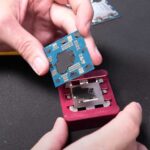Any startup is looking to solve a problem. Sometimes, it is not the one you first envisioned when you set up the company, as Mari-Ann Meigo Fonseca, co-founder of Tallin-based Gelatex can attest.
Gelatex manufactures 3D nanofibrous scaffolds for various applications, ranging from cell culture to tissue engineering.
“But we started the company with a completely different business idea in mind,” Meigo Fonseca tells TNW.
Initial target: the textile industry
Building a company is often less about sticking to an initial, rigid plan and more about embracing and adapting to changes along the way.
With a background in the textile industry and garment technology, Meigo Fonseca was initially seeking to contribute to the sustainability of the fashion sector — a mission that led her to pursue an MBA in Entrepreneurship and Technology Management at the University of Tartu in 2015.
There she met her co-founder, materials scientist and engineer Märt-Erik Martens.
In 2016, the duo participated in the ClimateLaunchpad competition and won with their idea of producing leather-like textile using gelatin nanofibres. They founded Gelatex the same year and continued developing the product.
“One of the first challenges we had was that, even if we could make the material work, we wouldn’t be able to manufacture it at scale with the existing production technologies,” Meigo Fonseca says.
“It would just be too costly.”
The birth of HaloSpin
The duo decided to solve the problem themselves, and in 2017, Martens developed a new nanofibre production technology he dubbed “HaloSpin.”
Halospinning works by spinning (or drawing) nanofibres from liquid polymer solutions without using electrostatic forces.
It’s faster than conventional alternatives such as electrospinning, and can increase production capacity by 100 times, Gelatex says. This translates to cost savings of up to 90%.
“The biggest industrial unit of electrospinning can cost about €8 million and can produce about 360 grams of nanofibers per hour,” Meigo Fonseca says.
“With our pilot machine we can produce 2.2kg per hour, and we are already building a machine [with a capacity] of 5kg per hour.”

Another advantage of the method are the unique morphology properties it delivers. This results in highly porous 3D scaffolds that can be customised to different materials and applications.
Pivoting to the medical sector and cultured meat
Thanks to halospinning, the startup moved towards the first product-market fit with several international companies.
But while there was interest, the company never got to the stage where it could actually sell the product.
“The COVID pandemic in 2020 was the start of a pivot for us,” she says. That’s when Gelatex began using its technology to mass-produce nanofibre filtering material for face masks.
The process enabled the founders to realise the full potential of nanofibres and identify the need for scalable production in cell culture.
From the same year onwards, Gelatex moved away from the textile industry and pivoted to producing nanofibrous materials for cultured meat as well as 3D cell culture and tissue engineering for the medical and pharma sector.
“Long-term, the biggest market for us is cultured meat production,” Meigo Fonsenca says. But given the sector’s regulatory challenges and the large investments needed for such companies to scale, in the next five years, Gelatex will be focusing on the medical sector.
Applications range from stem cell research and toxicology studies to drug discovery in 3D tissue models.
According to Meigo Fonseca, the journey from science to entrepreneurship is not an easy one. One piece of advice she has for founding teams is for the members to complement each other, combining both the scientific and the business background.



